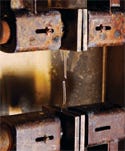Retooled testing techniques enabled better quality control of an oxygen-delivery device
March 2, 2008
Originally Published MPMN March 2008
NEED TO KNOW
University Research Unveils New Potential for Shape-Memory Materials
|
Researcher Ken Gall uses this thermomechanical test frame to determine the maximum possible shape change of his team's shape-memory polymer. |
Shape-memory alloys and polymers are the contortionists of the materials world. Able to stretch, be compressed, or change shape and then return to their original form, shape-memory materials have emerged as valuable new tools for medical applications. However, recent university research has revealed that the potential for shape-memory materials may extend far beyond the scope of initial investigations. Resulting in the discovery and further pursuit of the materials’ full range of capabilities, new developments are also bringing researchers closer to more-efficient and less-expensive ways to produce the materials for medical device manufacturers.
Shape-memory alloys—most notably nitinol—are common fixtures in minimally invasive devices. However, a research team at Georgia Institute of Technology (Atlanta; www.advancedmaterialslab.com) is concentrating on optimizing shape-memory polymers for medical applications. The shape of these polymers can be temporarily manipulated into forms several times larger or smaller than their original shape using heat, light, or the local chemical environment, according to Ken Gall, an engineering professor at Georgia Tech.
Noticing that traditional cardiovascular stents are metal but often feature a polymer sheath, Gall’s research team set out to put its shape-memory polymers to practical use. The team removed metal from the equation, resulting in a polymer-based stent. Polymers more closely resemble soft biological tissue than metal does, and they can also be designed to gradually dissolve into the body, according to Gall. He adds that polymers are also more flexible and don’t put as much stress on arterial walls as metals do.
The polymer stent is compressed and fed through a tiny hole into a blocked artery, like a traditional stent. Unlike a traditional stent, however, it is triggered by body heat to expand into its permanent state, deploying without the use of auxiliary devices. “You can tailor the polymer to moderate its strength, stiffness, stretchiness, and expansion rate,” Gall says.
With simultaneous projects researching the use of these polymers in minimally invasive spinal surgeries and neuronal probes, Gall’s team is also researching ways to produce the polymers for commercial medical applications. Graduate student Walter Voit is helping Gall investigate how to make the cost of shape-memory polymers in line with current medical-grade polymers. “This will have a big impact on Class I medical device applications,” says Gall.
Conducting similar research specifically for the treatment of strokes, the Livermore National Laboratory (Livermore, CA; www.llnl.gov), in partnership with the immunology and radiology departments at the University of California, Davis (Sacramento, CA; www.ucdmc.ucdavis.edu), has developed a clot-extraction system and a neurovascular stent using shape-memory polymers. The research team found that these polymers “[have] advantages over shape-memory metals for certain applications, including cost, higher recoverable strain levels, ease of manufacturing, better flexibility in navigating tortuous paths, and great versatility in fabricating extremely small, highly complex actuators.” It also found that preshaping foams that are made of shape-memory polymers to match the geometry of an aneurysm can enhance the ability to fill and seal cranial gaps with fewer complications.
Shape-memory foam structures are also the subject of research jointly conducted by professors Peter Müllner and David Dunand, at Boise State University (Boise, ID; www.boisestate.edu) and Northwestern University (Evanston, IL; www.dunand.northwestern.edu), respectively. Their research teams have developed a shape-memory foam made from a nickel-manganese-gallium alloy that can be lengthened by up to 10% when subjected to a magnetic field, according to the National Science Foundation, which funded the research.
Existing shape-memory alloys like nitinol are actuated through a change in temperature. This new alloy, however, is triggered using a magnetic field, which enables much faster actuation, according to Müllner. “For medical applications, that means that devices may operate at a specific time,” he says. “The actuation may also be reversed, [meaning] a function might be turned on and off. That is not possible with nitinol-based medical devices, [which] are controlled by body temperature and therefore have only an ‘on’ function,” he adds.
The teams use a process to introduce voids into the alloy crystals to make the material porous. “The porous nature of the material amplifies the shape-change effect, making it a good candidate for tiny motion control devices or biomedical pumps without moving parts,” he says.
Copyright ©2008 Medical Product Manufacturing News
You May Also Like



